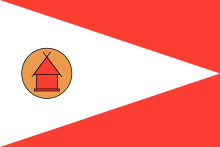Merina people
The Merina people (also known as the Imerina, Antimerina, Borizany or Ambaniandro[3]) formerly called Amboalambo are the largest ethnic group in Madagascar.[6][7] Their origins are mixed, predominantly with Austronesians arriving before the 6th century AD with Bantu Africans resulting in a core population known as Vazimba, later by large number of Neo-Austronesians and a minority of Arabs, Indians and Europeans.Oral history traces the emergence of a united kingdom in the central highlands of Madagascar – a region called Imerina – back to early 16th-century king Andriamanelo.By 1824, a succession of Merina kings had conquered nearly all of Madagascar, particularly through the military strategy, ambitious treaties and political policies of Andrianampoinimerina (circa 1785–1810) and his son Radama I (1792–1828).[17][18] The slavery was abolished by the French administration in 1896, which adversely impacted the fortunes of Merina and non-Merina operated slave-run plantations.[19][20] The dominance of the Merina kingdom over all of Madagascar came to an end with the first Franco-Hova War of 1883 to 1885, triggered by the disputed lease signed by Radama II.[20] The Second Franco-Hova War followed in 1895, when the French military landed in Mahajanga (Majunga) and marched by way of the Betsiboka River to the capital, Antananarivo, taking the city's defenders by surprise.A secret society dedicated to affirming Malagasy cultural identity was formed in 1913, calling itself Iron and Stone Network (in local language, Vy Vato Sakelika – VVS).The first president of the Republic, Philibert Tsiranana, was a coastal Malagasy of Tsimihety ethnicity, and he was able to consolidate his power with a winner-takes-all system, while the Merina nationalists of the Congress Party for the Independence of Madagascar was weakened by rifts between leftist and ultranationalist factions.[25] Due to the influence of British missionaries, the Merina upper classes converted to Protestantism entirely in the mid-19th century, following the example of their queen, Ranavalona II.The early spread of Protestantism among the Merina elite resulted in a degree of class and ethnic differentiation among practitioners of Christianity.It has been speculated that the Vazimba were the original population of Madagascar, descended from Southeast Asian seafarers who may have had pygmy physical characteristics.The Merina people also ritually kill their cattle with unusual violence, cook and consume beef prepared thereafter ceremoniously.


MadagascarMalagasyFrenchChristianitysyncreticBetsileoAustronesian peoplesBantu peoplesofficial ethnic groupsAustronesiansAntananarivo ProvinceMerina sovereignsRadama Icolonized Madagascarsocially stratifiedcastesendogamyMerina KingdomMalagasy ProtectorateHistory of MadagascarAustronesiansoutheast AsianOceanianSwahili-ArabsIndianSakalava kingdomBetsimisaraka kingdomAndriamaneloAndrianampoinimerinaRanavalona IRasoherinaRanavalona IIJoseph-François LambertMakua peopleMozambiquefirst Franco-Hova WarAntsirananagold francsRadama IISecond Franco-Hova WarMahajangaBetsiboka RiverAntananarivoFrench MadagascarVy Vato SakelikaMalagasy RepublicPhilibert TsirananaTsimihetyCongress Party for the Independence of MadagascarMalagasy languageLondon Missionary SocietyRanavalona IIcontemporary demographicsAndrianaHova (Madagascar)AndevoVazimbacircumcisedcuisine of the MerinaRalamboMalagasy peopleOxford University PressCambridge University PressUniversity of California PressSteven L. DanverIndigenousAntaifasyAntemoroAntaisakaAntambahoakaAntandroyAntankaranaAntanosyBetsimisarakaBezanozanoMahafalyMasikoroSakalavaSihanakaTanalaZafimaniryZafisoroKarana (Indian)Sinoa (Chinese)Vazaha (European)